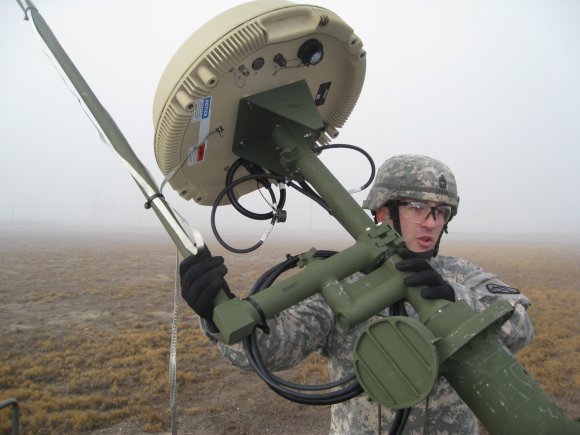By SYDNEY J. FREEDBERG JR.
An Army soldier sets up a highband antenna in Afghanistan.
AOC: With so many troops, tanks, ships, and planes transmitting on so many different frequencies that they accidentally jam each other hundreds of times a year, the US military lives and dies by the radio frequency spectrum. That’s why the Defense Information Services Agency (DISA) is pulling together data from all four armed services to create a single massive database of signals, the Joint Spectrum Data Repository.
The JSDR won’t just keep American communications officers from mistakenly scrambling each others’ signals, either. By providing a comprehensive baseline of what friendly transmissions look like, the mega-database will make it easier for Signals Intelligence (SIGINT) and Electronic Warfare (EW) troops to hone in on enemy transmission.
What’s more, by building on other Pentagon investments — cloud computing to pool all this data, secure, jam-proof satellite communications to share it, big data analysis and ultimately artificial intelligence — the Joint Spectrum Data Repository will be able to provide data “near-real time” to users worldwide, DOD’s Chief Information Officer, Dana Deasy, said here.
The key realization, Deasy told the Association of Old Crows electronic warfare conference: Just as the radio spectrum is critical to everything else the Defense Department does, a lot of DoD’s other initiatives have useful applications to the spectrum, too. “Military applications for the cloud, AI, and cyber all depend on the ability to access and maneuver within the electromagnetic spectrum (EMS),” he said. Conversely, “I can tell you the DoD plans to leverage cloud, AI, and cyber to enhance activities in EMS.”
“Consolidating EMS data into a single source for ease of access… has massive potential when combined with both milCloud and JEDI,” Deasy said, referring to two major Pentagon initiatives in cloud computing that could provide global access to the Joint Spectrum Data Repository. JEDI in particular is intended to connect frontline combat units to the cloud.
Another vital part of getting data into cockpits and trenches, Deasy said, is the DoD’s major investment in secure radio communications — essentially, military-strength wifi — that can resist enemy jamming and hacking.
But supporting frontline commanders requires more than getting the data to them: It requires figuring out which data is worth sending in the first place. In a world of wifi and cellphones, however, there are so many different friendly, enemy, neutral, and civilian transmissions all the time that the raw data is overwhelming.
Today, sorting out what’s significant requires a tremendous amount of human labor, Deasy said, but the new Joint Artificial Intelligence Center will help create AI toolsthat can take on much of the data crunching. DoD is holding a major industry day tomorrow for contractors interested in the new center.

No comments:
Post a Comment